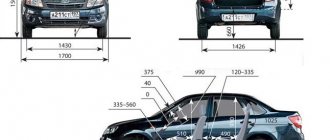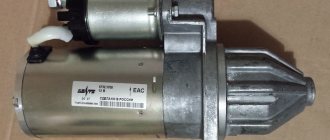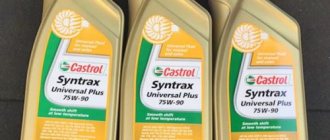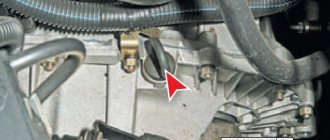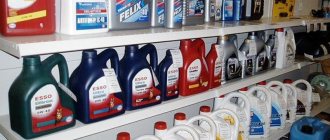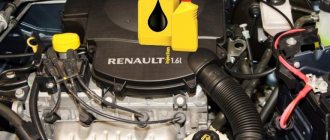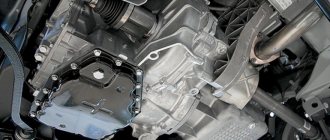Short description
Transmission oil TAD-17 is made by distilling sulfur category oil. The process removes excess hydrocarbon compounds and foreign impurities from the composition. This approach guarantees the utmost purity of the mineral base.
The formula is supplemented with a complex of highly specialized additives. Additional components increase the performance of the base. The main components are depressant, detergent, and dispersant additives. The result of mixing is the optimization of temperature resistance, increasing the protective characteristics of the liquid.
TAD 17 and TAP 15
TAP 15 often has a “B” after the type of oil, which means all-season. Technical characteristics of TAP 15 :
- Density at t 25ºС = 930 kg per m3;
- Viscosity at t 100ºС about 16:
- Pour point -20ºС;
- Sulfur content: no more than 3.0%;
Comparing these two oils, we note that TAP 15 is more used for specialized equipment. It is used in such machines and mechanisms as:
- in boxes and other rotating mechanisms on trucks and tractors, construction, road and agricultural special equipment;
- on conveyors of various industries, for lubrication of bevel, worm and spiral gears in various units and devices;
- mechanisms and gears operating with heavy loads on parts;
- for lubrication of railway rolling stock - locomotives and cars.
That is, there are also specifics of application for various types of technical devices.
Where is TAD-17 used?
The lubricant is designed for servicing manual gearboxes, transmission units, gearboxes, and axles of passenger cars. The oil meets the requirements of light trucks and passenger cars. Suitability for use in agricultural, construction and highly specialized equipment is also noted.
The lubricant effectively protects hypoid, worm, and cylindrical gears.
Purpose
The oil is recommended for use in manual transmissions, axles and transfer mechanisms for domestic , but can also be used in other areas of mechanics:
- for agricultural machinery;
- for attachments;
- for stationary installations with rotating gear mechanisms.
- for long-term preservation of equipment.
is not used for automatic transmissions .
TAD 17 is used for the following purposes:
- protection of metal surfaces from corrosion;
- reducing friction and wear;
- preventing jamming in mechanisms;
- from the formation of pitting (cavities) on gears;
- heat removal;
- reducing the noise of machinery.
Main settings
Oil TAD 17 technical characteristics:
| Index | Meaning |
| Kinematic viscosity at +50˚С | 115 |
| Kinematic viscosity at +100 ˚С | 17,5 |
| Viscosity index | 100 |
| Ignition threshold in an open crucible ˚С | +200 |
| Crystallization threshold ˚С | -25 |
| Sulfate ash content | 0,3% |
| Sulfur content % | 2 |
| SAE Compliance | 85W90 |
| Category | GL-5 |
Tad-17: price per liter
The price range for this brand of gear oil is determined by the financial policy of the manufacturers, as well as the packaging of the products. The price range for the product varies depending on its packaging:
- In large packaging (barrels of 180...195 kg) - up to 55 rubles/l.
- In medium packaging (20 l canisters) – up to 80 rubles/l.
- In small packaging (1 liter canisters) – up to 100 rubles/liter.
Dumping the price of Tad-17 may indicate poor-quality technology for preparing the lubricant, the likelihood of its dilution during the packaging process, as well as the replacement of some components with cheaper analogues. Therefore, in doubtful situations, it makes sense to familiarize yourself with the product certificate and check whether the technical characteristics of the lubricant comply with the current standards.
Specifications
If we look at the technical documentation, the wording of TAD-17 is considered outdated. Today it has been replaced by a newer one, TM-8-15, provided for by GOST 17479.2-85. Although there have been no changes in the chemical composition and performance requirements.
The state standard provides for extensive research of lubricants. However, most of the characteristics obtained in the research are applied narrowly and have practically no effect on real operating statistics. Let's look only at the main technical characteristics of the TAD-17.
- Base oil. The basis for TAD-17 (TM-8-15) is a highly purified mineral base with a low content of sulfur inclusions.
- Additives. This gear oil is modified with a standard additive package for lubricants of this level. Anti-foam, antioxidant, extreme pressure and thickening additives give the relatively simple mineral base high performance qualities.
- Viscosity. The kinematic viscosity of TAD-17 is studied at a temperature of 100 °C, that is, at the operating temperature of a heavily loaded transmission unit. For TAD-17 this parameter ranges from 14 to 25 cSt. Most manufacturers of this oil adhere to 17-18 cSt at 100 °C, which is reflected in the name of the lubricant.
- Viscosity index. GOST requires keeping the viscosity index for TAD-17 at a level of at least 100 units. Modern technologies for obtaining the mineral base and effective depressant additives make it possible to obtain the required indicator without any problems.
- Flash point. When heated in an open crucible, the oil in question ignites no earlier than after reaching a temperature of +200 °C. This is a high figure for a mineral lubricant.
- Pour point. The lubricant loses fluidity and becomes plastic no earlier than the temperature drops to –25 °C. This oil is not suitable for use in the Far North.
- Density. One liter of TAD-17 lubricant weighs 907 (+–1%) grams. Average for mineral-based lubricants.
As the results of independent studies have shown, today the characteristics of TAD-17 significantly exceed the minimum requirements established by GOST.
Nigrol or Tad-17: which is better?
When choosing a brand of gear oil, you should pay attention not to its name, but to its performance characteristics. They, firstly, must comply with the requirements of the standard, and, secondly, not have a large spread over the range. For example, if a little-known manufacturer indicates that the density of gear oil is in the range of 890...910 kg/m 3 (which formally does not exceed the permissible limits), then one can doubt the stability of the indicators: it is likely that such “nigrol” was obtained by mechanical mixing several components unknown to the consumer. The same caution applies to other parameters.
The most reliable producers of modern “nigrol” are the FOXY, Agrinol, and Oilright brands.
And finally: be careful with products that, judging by the label, are produced not according to GOST 23652-79, but according to industry specifications or, even worse, factory specifications!
Transmission oil TAD-17 is a prominent representative of Russian transmission oils. The wide scope of its application and accessibility generates logical interest among motorists.
Analogs
TAD 17 oil is not available today. Instead, you can find an analogue of TM-5-18. If you cannot find this product on sale, then you can purchase any other lubricant that meets the above characteristics. The main thing is that the product belongs to API class GL-4.
What oils can be used instead of TAD 17:
- Motul;
- Castrol Synstrans;
- Castrol Manual;
- Castrol Syntrax Universal;
- Liquid Moly;
- Zeke;
- VAG;
- Mobile;
- Lukoil;
- Alpine Gear;
- Mannol Universal;
- Hexol Sinline;
- Favorite;
- Yukoil;
- Titan Supergear.
TAD - 17 = GL 5 How can this be?
https://www.autolub.info/dopuski/vaz3.shtml
3.1 Historical background
In 1970, for the first refueling and operation of transmission units of VAZ vehicles, transmission lubricating oil TAD-17i was developed and introduced, which was produced from base oils of the Omsk Refinery with a package of additives Anglomol-99 from Lubrizol. TAD-17i oil was an analogue of FIAT oil W/90M and, according to foreign classifications of that time, met the requirements of SAE class 90 and API group GL-5. In the 90s, the range of transmission lubricating oils of this quality level increased significantly, and other additives began to be used for their production.
In the early 80s, during the development of cars of the VAZ-2108 family, it was found that TAD-17i lubricating oil did not provide the required durability of brass synchronizers.
To fill transmissions of the VAZ-2108 family, it was recommended to use SAE 80 W class oils according to API group GL-4 or M-10Gi engine oil. Since there was no production of transmission lubricating oil of this level of quality, and the issue of using two transmission oils during assembly had not been worked out, for the first refueling of KP-2108, M-8Gi oil was introduced, which was used for the first refueling of engines. Operating experience of the KP-2108 showed in subsequent years that engine oil does not fully provide the required durability of the gearbox differential. Lubricating oils according to API GL-4 were developed for the operation of KP-2108.
However, their range and production volumes are still limited.
3.2 Transmission lubricating oils of the Hypoid group
Technical requirements for these oils are set out in draft RD 3148.37.101.002-2001 and TTM 1.97.0716-98. These oils (see Appendix B) are intended for use in lubrication systems of front and rear axles, transfer cases and steering worm gearboxes of vehicles with rear-wheel drive (VAZ-2101 VAZ-2107) and vehicles with 4-wheel drive (VAZ-2121 and VAZ-21213, VAZ-2123 and their modifications) in various climatic zones.
The Appendix does not contain TAD-17i oil according to GOST 23652-79, since its production was discontinued along with the cessation of purchases of the Anglomol-99 additive. Currently, purchases of this additive have been resumed, however, lubricating oils in which the Anglomol-99 additive is used must have a trademark and designation according to SAE and API. Lubricating oils under the brand name TAD-17 and AVTOVAZ will not be allowed for use, since the oils sold today under this name are 100% counterfeits and of very low quality. AVTOVAZ gave approval only for TAD-17 oil produced at the Omsk Oil Refinery.
All lubricating oils listed in Appendix B, of various SAE viscosity classes, have the level of extreme pressure properties of TAD-17 oil or even exceed it.
The timing of changing lubricating oils must be carried out in accordance with the vehicle operating manuals.
3.3 Transmission lubricating oils of the “trans KP” group for gearboxes
Technical requirements for lubricating oils for gearboxes are set out in draft RD 3148.37.101.002-2001 and TTM 1.97-0729-98. For more than 10 years, gearboxes were filled with only motor oils, which did not sufficiently provide the required reliability and durability of gearboxes. In 1996, a special oil was developed only for TNK TRANS KP gearboxes (literally called “ROLS T”) SAE 80W-85 API GL-4. In 1998, another oil that met the requirements of AVTOVAZ JSC, LUKOIL TM-4 SAE 80W-90, was approved, and in 2001, lubricating oils from ESSO were approved.
The list of oils is given in Appendix B.
Recommended application ranges for transmission lubricating oils are given in Table 3
